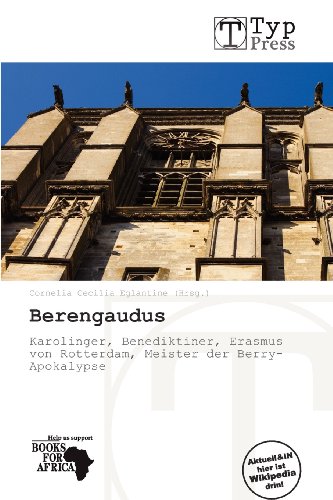Berengaudus
Berengaudus (* probably in the 9th century ) was a Carolingian Benedictine monastery in Ferrieres -en- Gâtinais, Loiret. It is therefore sometimes referred to with Beinamem Berengaudus Ferrariensis and lived well before 865 at the time of Abbot Lupus in Ferrieres. Berengaudus is known for its super text Expositio libri septem visiones Apocalypsi, a commentary on the Book of Revelation ( Apocalypse ). The author's name is encrypted called it, one of the oldest manuscripts of the 12th century was found in Angers. Because of Textinterpration but the emergence can be placed convincingly in the 9th century, although copies are obtained only from the time afterwards.
About 50 copies of the commentary primarily from the 12th century were in French monasteries around Paris and Troyes, for example, found, but also in England ( Peterborough or Cambridge ). The Lambeth Apocalypse from the 11th century brings excerpts from this comment. So the work was more widespread and there are further indications that it was known and famous mainly in the 12th century. Sometimes today the erroneous assignment of the work of Ambrose of Milan is cited as a reason this former renown, and Erasmus of Rotterdam zusprach the text. Be found even in the 14th century copies of the commentary, such as in the area illustrated by the Master of the Berry Apocalypse Book of Revelation from the estate of Jean de Valois, Duke of Berry, or even in a dating from the same century copy of the work of Bavarian monasteries. However, until the final determination of the question of authorship by the Paris Maurinerpatres in the 18th century called Berengaudus clearly as the author.
Berengaudus has a different, own interpretation compared to other commentators on the Apocalypse. The Four Horsemen of the Apocalypse are not him incarnations of evil, but of him these riders are interpreted on the white, the red, the black and the fallow Ross as Christ himself, the bearer of a new world. Optimism and utopian hope in the face of the world court is felt even before then a apocalyptic mood begins to be regarded as disaster warning and in the 12th century near the court for the people. Berengaudus sees the apocalypse as the beginning of a new world, an interpretation that can be find in the vision of the Ghent altarpiece in the late Middle Ages in Flanders, showing how the unique visual language of Berengaudus - text a " visionary " interpretation and by Berengaudus created ideas seem to repeat in the late Middle ages.
The comment is the only surviving of Berengaudus text.









